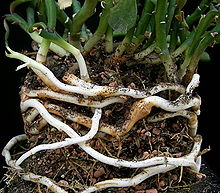Rhizome


In
A rhizome is the main stem of the plant that runs underground horizontally.[5] A stolon is similar to a rhizome, but a stolon sprouts from an existing stem, has long internodes, and generates new shoots at the end, such as in the strawberry plant. In general, rhizomes have short internodes, send out roots from the bottom of the nodes, and generate new upward-growing shoots from the top of the nodes.
A
The plant uses the rhizome to store
Stored rhizomes are subject to bacterial and fungal infections, making them unsuitable for replanting and greatly diminishing stocks. However, rhizomes can also be produced artificially from tissue cultures. The ability to easily grow rhizomes from tissue cultures leads to better stocks for replanting and greater yields.[7] The plant hormones ethylene and jasmonic acid have been found to help induce and regulate the growth of rhizomes, specifically in rhubarb. Ethylene that was applied externally was found to affect internal ethylene levels, allowing easy manipulations of ethylene concentrations.[8] Knowledge of how to use these hormones to induce rhizome growth could help farmers and biologists to produce plants grown from rhizomes, and more easily cultivate and grow better plants.
Some plants have rhizomes that grow above ground or that lie at the soil surface, including some

Many rhizomes have culinary value, and some, such as
See also
References
- Perseus Project
- ^ ῥιζόω
- ^ "rhizome | Description, Functions, & Examples". Encyclopedia Britannica. Retrieved 15 June 2021.
- ^ PMID 16998090.
- JSTOR 23019767.
- ISBN 0-07-290941-2.
- .
- S2CID 6630060.
- ^ Hogan, C. Michael (2008). Stromberg, Nicklas (ed.). "Western Poison-oak (Toxicodendron diversilobum)". GlobalTwitcher. Archived from the original on 21 July 2009.
- ^ Husby, C. (2003). "Ecology and Physiology of the Giant Horsetails". Florida International University. Archived from the original on 14 July 2009.
- ISBN 978-3-319-26061-7.[page needed]
- ^ "Ginger | plant". Encyclopedia Britannica. Retrieved 15 December 2020.
- ^ "turmeric | Description, History, & Uses". Encyclopedia Britannica. Retrieved 15 December 2020.
- JSTOR 4114957.
External links
 Media related to Rhizomes at Wikimedia Commons
Media related to Rhizomes at Wikimedia Commons
